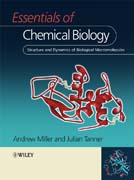
Essentials of chemical biology: structure and dynamics of biological macromolecules
Miller, Andrew D.
Tanner, Julian
Chemical Biology: Structure and Dynamics of Biomolecules addresses recent developments in the field and builds on the foundations laid by introductory physical chemistry courses. The book offers a comprehensive introduction to undergraduate and early postgraduate chemists to enhance their understanding of the underlying principles behind the functioning of molecules. To enable readers to understand the bridge from the biomolecules to biology, the book provides additional pedagogical elements to allow the student to make these important links and understand the context of techniques and examples discussed in the book. INDICE: Preface. Mapping the essentials of chemical biology. Glossary of physical terms. 1. The structures of biological macromolecules and lipid assemblies. 1.1 General introduction. 1.2 Protein structure. 1.3 Carbohydrate structure. 1.4 Nucleic acid structure. 1.5 Macromolecular lipid assemblies. 1.6 Structural forces in biological macromolecules. 2. Chemical and biological synthesis. 2.1 Introduction to synthesis in chemical biology. 2.2 Chemical synthesis of peptides and proteins. 2.3 Chemical synthesis of nucleic acids. 2.4 Chemical synthesis of oligosaccharides. 2.5 Chemical synthesis of lipids. 2.6 Biological synthesis of biological macromolecules. 2.7 Directed biological synthesis of proteins. 2.8 Biological syntheses of nucleic acids, oligosaccharides and lipids. 3. Molecular biology as a toolset for chemical biology. 3.1 Key concepts in molecular biology. 3.2 Tools and techniques in molecular biology. 3.3 Cloning and identification of genes in DNA. 3.4 Integrating cloning and expression. 3.5 Site-directed mutagenesis. 4. Electronic and vibrational spectroscopy. 4.1 Electronic and vibrational spectroscopy in chemical biology. 4.2 UV-visible spectroscopy. 4.3 Circular dichroism spectroscopy. 4.4 Vibrational spectroscopy. 4.5 Fluorescence spectroscopy. 4.6 Probing metal centres in biological systems by spectroscopy. 5. Magnetic resonance. 5.1 Magnetic resonance in chemical biology. 5.2 Key principles of NMR. 5.3 Two-dimensional NMR. 5.4 Multi-dimensional NMR. 5.5 Biological macromolecule structural information. 5.6 EPR spectroscopy; key principles. 6. Diffraction and microscopy. 6.1 Diffraction and microscopy in chemical biology. 6.2 Key principles of X-ray diffraction. 6.3 Structural information from X-ray diffraction. 6.4 Neutron diffraction. 6.5 Key principles of electron microscopy. 6.6 Key principles of scanning probe microscopy. 7. Molecular recognition and binding. 7.1 Molecular recognition and binding in chemical biology. 7.2 Theoretical models of binding. 7.3 Analysing molecular recognition and binding. 7.4 Biological molecular recognition studies. 8. Kinetics and catalysis. 8.1 Catalysis in chemical biology. 8.2 Steady state kinetic schemes. 8.3 Pre-steady-state kinetics. 8.4 Theories of biocatalysis. 8.5 Electron transfer. 9. Mass spectrometry and proteomics. 9.1 Mass spectrometry in chemical biology. 9.2 Key principles in mass spectrometry 9.3 Structural analysis of biological macromolecules and lipids by mass spectrometry. 9.4 The challenge of proteomics. 9.5 Genomics - assigning function to genes and proteins. 10. Molecular selection and evolution. 10.1 Chemical biology and the origins of life. 10.2 Molecular breeding; natural selection acting on self-organisation. 10.3 Directed evolution of protein function. 10.4 Directed evolution of nucleic acids. 10.5 Catalytic antibodies.
- ISBN: 978-0-470-84530-1
- Editorial: John Wiley & Sons
- Encuadernacion: Cartoné
- Páginas: 360
- Fecha Publicación: 28/03/2008
- Nº Volúmenes: 1
- Idioma: Inglés
